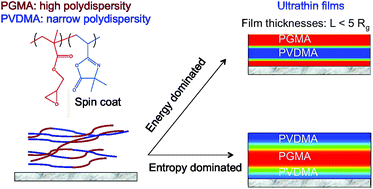Microphase separation in thin films of lamellar forming polydisperse di-block copolymers†
Abstract
Despite the ubiquity of polydispersity in chain lengths of di-block copolymers, its effects on microphase separation in thin films have eluded a clear understanding. In this work, we have studied effects of polydispersity on the microphase separation in thin films of lamellar forming di-block copolymers using self-consistent field theory (SCFT) and neutron reflectivity experiments. Di-block copolymers containing a polydisperse block of poly(glycidylmethacrylate) (PGMA) connected to a near-monodisperse block poly(2-vinyl-4,4-dimethyl-d6 azlactone) (PVDMA-d6) are considered in this work. Effects of chain length polydispersity, film thickness, substrate–monomer and monomer–monomer interactions on the microphase segregation are studied using SCFT. The theoretical study reveals that in comparison to a film created with monodisperse di-block copolymers, an increase in polydispersity tends to decrease the number of lamellar strata that can be packed in a film of given thickness. This is a direct consequence of an increase in lamellar domain spacing with an increase in polydispersity index. Furthermore, it is shown that polydispersity induces conformational asymmetry and an increase in the polydispersity index leads to an increase in the effective Kuhn segment length of the polydisperse blocks. It is shown that the conformational asymmetry effects, which are entropic in origin and of increasing importance as film thickness decreases, drive the polydisperse blocks to the middle of the films despite favorable substrate interactions. These predictions are verified by results from neutron reflectivity experiments on thin films made from moderately polydisperse PGMA-PVDMA-d6 di-block copolymer deposited on silicon substrates. Finally, results from SCFT are used to predict neutron reflectivity profiles, providing a facile and robust route to obtain useful physical insights into the structure of polydisperse diblock copolymers at interfaces.


 Please wait while we load your content...
Please wait while we load your content...